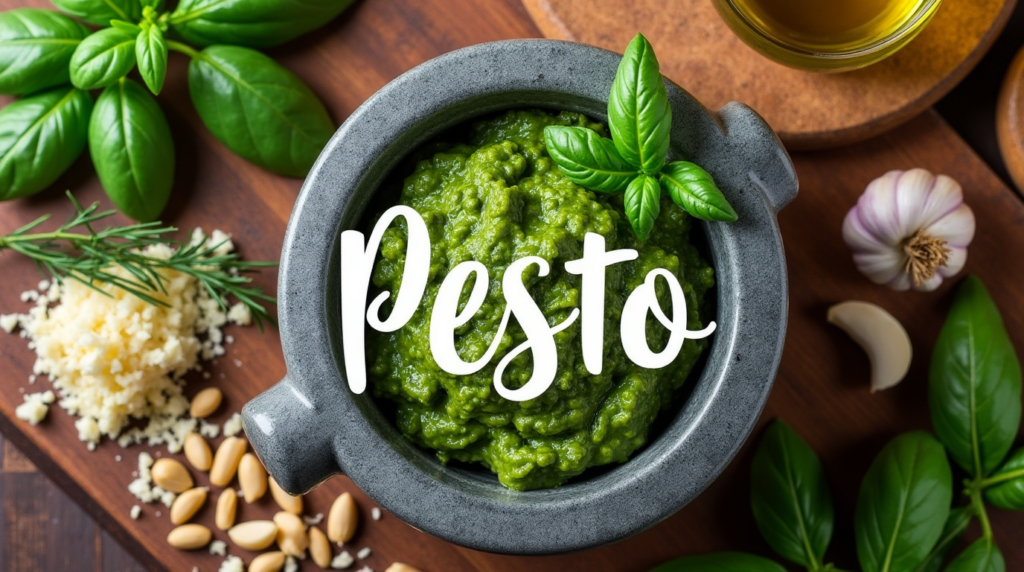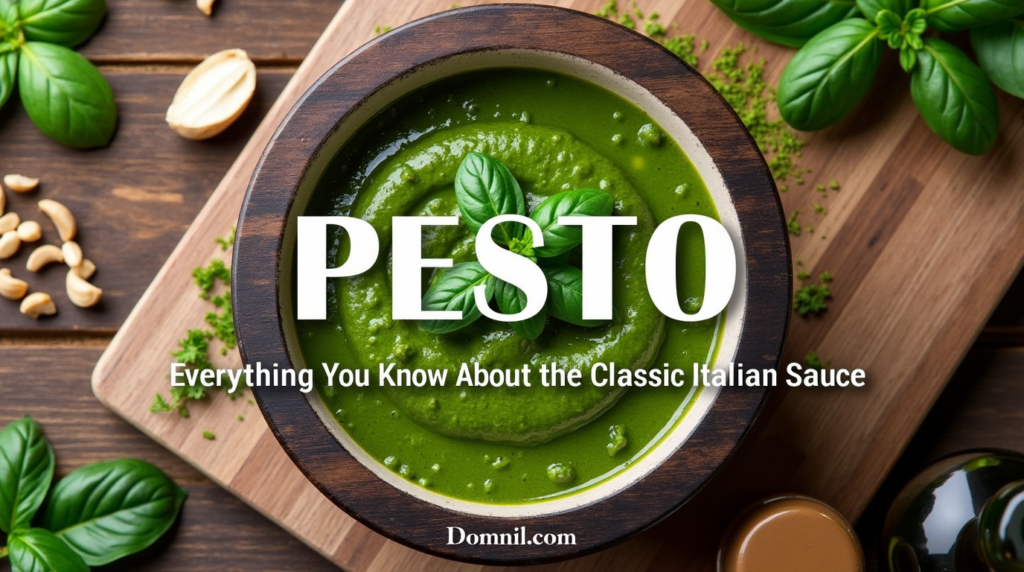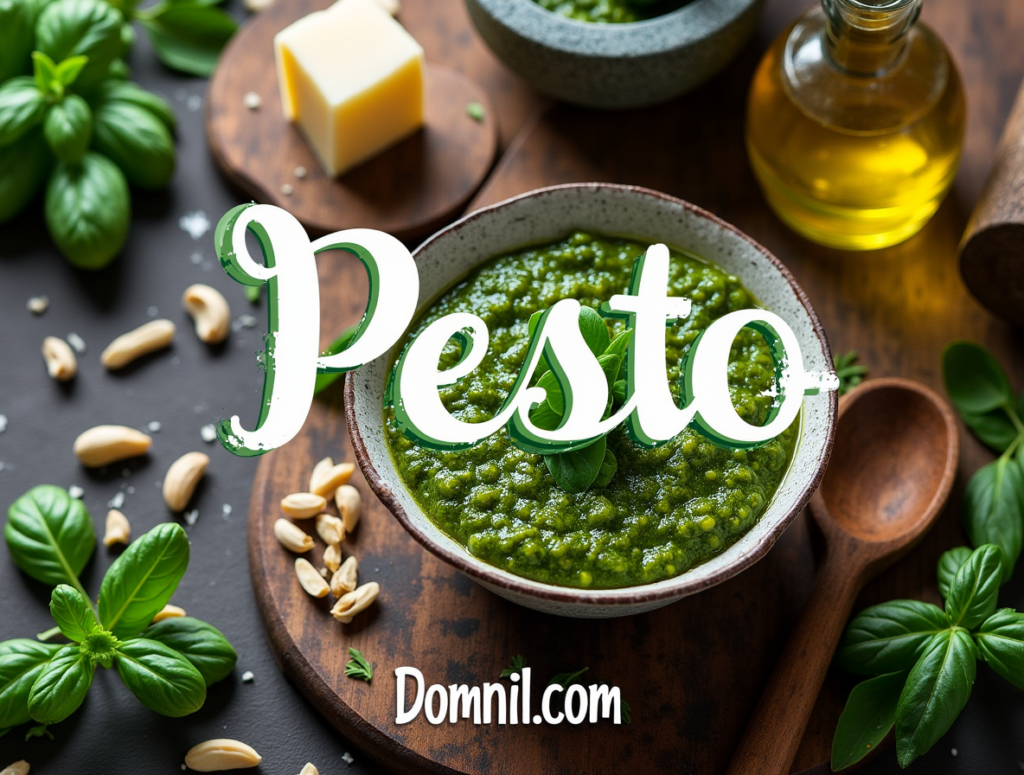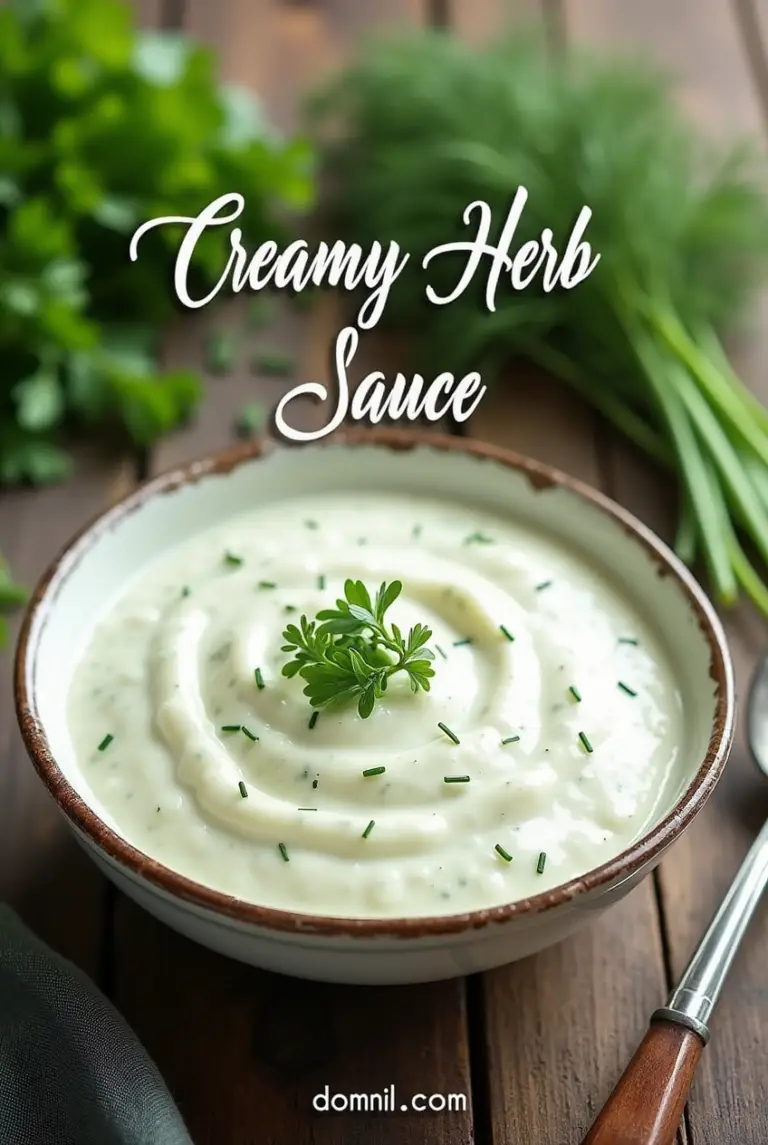Pesto: Everything You Need to Know About the Classic Italian Sauce
What is Pesto?
Pesto is one of those magical sauces that can instantly elevate a dish with its vibrant green hue and punchy flavor. But what is pesto, really? At its core, pesto is a blend of fresh basil leaves, pine nuts, garlic, Parmesan cheese, and olive oil. It’s typically uncooked and ground into a paste using a mortar and pestle, though blenders and food processors have become the modern-day go-to.
But pesto is more than just a sauce—it’s a celebration of simplicity, freshness, and the richness of Mediterranean cuisine. With its bold, herby aroma and nutty undertones, it can transform a plain bowl of pasta into something gourmet, or act as a flavorful spread for sandwiches, dips, and more.
Its versatility is one of the many reasons pesto has stood the test of time. Whether you’re tossing it with gnocchi, spooning it over grilled chicken, or spreading it on crusty bread, there’s no denying pesto’s power to impress.

Table of Contents
The Origins of Pesto
To understand pesto’s magic, you have to go back in time—way back to ancient Rome. While the green sauce we know and love today originated in Genoa, the idea of combining herbs with cheese and oil has been around for centuries. Ancient Romans made a similar paste called “moretum,” which included herbs, garlic, salt, cheese, olive oil, and vinegar.
However, the modern version of pesto—Pesto alla Genovese—truly came to life in the Liguria region of northern Italy. The word “pesto” comes from the Italian verb pestare, meaning “to pound” or “to crush.” This is a nod to the traditional preparation method using a mortar and pestle to grind ingredients into a paste.
In Liguria, basil grows abundantly in the warm, Mediterranean climate, making it the perfect centerpiece for this now-famous sauce. Local pine nuts, cheese from nearby Parma and Sardinia, and rich Ligurian olive oil came together to create what we now recognize as authentic pesto.
Today, pesto is a global phenomenon—but its roots remain deeply tied to Italian culture and the pride of Ligurian cuisine.
Traditional Ingredients Used in Pesto
If you want to make true Pesto alla Genovese, you’ve got to honor the traditional ingredients. These aren’t just selected at random—each one brings its own layer of flavor and texture:
- Fresh Basil Leaves – The soul of pesto. Only use fresh, young basil leaves, preferably Genovese basil, which has a sweet, aromatic flavor.
- Garlic – Adds sharpness and depth. In Italy, Ligurian garlic is often preferred for its milder taste.
- Pine Nuts – These buttery nuts add creaminess and a slight sweetness. Toasting them can enhance their flavor.
- Parmesan Cheese (Parmigiano-Reggiano) – Brings a salty, umami richness that balances the herbs.
- Pecorino Cheese – Sometimes combined with Parmesan, this sheep’s milk cheese gives a bolder, tangier flavor.
- Extra Virgin Olive Oil – Binds everything together and adds a fruity, peppery note. The quality of oil matters—go for the best you can find.
- Salt – Enhances the overall taste and brings out the natural flavors of each component.
These ingredients, when combined, create a balance of herbal freshness, nutty richness, and savory depth that makes pesto irresistible. While variations exist (and we’ll get to them), sticking to these core ingredients ensures you’re getting a taste of true Italian heritage.
Different Types of Pesto
While the classic green basil pesto reigns supreme, there are actually many variations of this beloved sauce. Each type brings its own unique flair to the table, reflecting regional tastes and seasonal ingredients.
Classic Basil Pesto (Pesto alla Genovese)
This is the OG of pesto sauces and the version most people think of when they hear “pesto.” Originating from Genoa, this version is all about high-quality, fresh ingredients. The basil should be fragrant and not too bitter; the pine nuts soft and buttery; the cheese rich and nutty. When done right, the result is a creamy, vibrant green sauce that smells like summer in Italy.
You can use it traditionally—mixed into pasta like trofie or trenette with boiled potatoes and green beans (a Ligurian specialty). Or go rogue and slather it on a pizza base, swirl it into soups, or spoon it over scrambled eggs. The possibilities are endless.
And here’s the kicker: in Italy, pesto isn’t always cooked. Heating it too much can dull its vibrant color and flavor. Instead, it’s usually added at the very end of cooking—or even just before serving—to maintain its freshness.
Pesto Variations Across Regions
Italy is a land of regional diversity, and pesto is no exception. Different areas have adapted the traditional recipe to suit their local ingredients and preferences. These variations are every bit as delicious and worth trying if you want to expand your pesto game.
Pesto Rosso (Red Pesto)
This Sicilian twist on the original swaps out basil for sun-dried tomatoes, giving it a deep red color and rich, tangy flavor. Pesto Rosso typically includes garlic, almonds or pine nuts, grated Parmesan, olive oil, and sometimes even roasted red peppers for added depth. It’s less herby than the green version but has a smoky sweetness that pairs beautifully with pasta, grilled meats, or even as a marinade.
If you’re a fan of bold, savory dishes, red pesto is your new best friend. It works wonders with spaghetti or spread onto a slice of toasted ciabatta. Think of it as pesto’s edgier cousin—one that adds a hearty touch to any meal.
Sicilian Pesto
Sicily’s climate is ideal for growing a variety of fresh herbs and nuts, which has led to some creative spins on the classic recipe. One well-known Sicilian variation includes fresh tomatoes, ricotta cheese, almonds, garlic, and basil, blended into a creamy, slightly sweet sauce.
Unlike the Genovese version, this pesto is often served cold over hot pasta, allowing the flavors to melt together naturally. The ricotta adds a silky texture that makes it feel like a cross between pesto and a creamy tomato sauce.
It’s perfect for hot summer days when you want something refreshing but satisfying. Add grilled shrimp or vegetables, and you’ve got yourself a Mediterranean masterpiece.
Vegan Pesto Alternatives
The beauty of pesto is how adaptable it is. Don’t eat cheese or avoid dairy altogether? No problem. Vegan pesto has become increasingly popular, and for good reason—it still tastes amazing. Nutritional yeast often steps in for Parmesan, providing that signature umami flavor. Cashews or almonds can be used in place of pine nuts, and of course, the olive oil and basil remain staples.
Some variations even throw in spinach or kale to boost the nutritional value. Vegan pesto is not only dairy-free but often more affordable and just as versatile. Spread it on avocado toast, mix it into grain bowls, or toss it with spiralized veggies for a low-carb treat.

How to Make Authentic Pesto at Home
Store-bought pesto might be convenient, but nothing compares to the taste of homemade. When you make it yourself, you get to control the freshness, texture, and quality of ingredients—plus, it just feels satisfying to whip up a batch of your own green gold.
Step-by-Step Guide to Homemade Pesto
Here’s how to make a traditional Pesto alla Genovese the authentic Italian way:
Ingredients:
- 2 cups fresh basil leaves (packed)
- 2 cloves garlic
- 1/3 cup pine nuts
- 1/2 cup freshly grated Parmesan cheese
- 1/4 cup freshly grated Pecorino cheese (optional)
- 1/2 cup extra virgin olive oil
- Salt to taste
Instructions:
- Toast the pine nuts in a dry skillet over medium heat for 3–5 minutes, until golden. Let them cool.
- Blend garlic and pine nuts in a food processor or mortar and pestle until finely chopped.
- Add basil leaves gradually, pulsing or grinding until you get a chunky paste.
- Mix in the cheeses, pulsing a few more times.
- Drizzle in olive oil slowly while blending until you get a smooth, creamy consistency.
- Season with salt to taste.
And there you have it—homemade pesto that’s fresh, fragrant, and infinitely better than anything in a jar.
Tools and Techniques for the Perfect Texture
Traditionally, pesto was made using a mortar and pestle—and if you’re a purist or just feeling adventurous, it’s absolutely worth trying at least once. Crushing the basil gently helps release its essential oils, giving the sauce a more aromatic flavor.
If you’re short on time or energy, a food processor or high-speed blender will still yield fantastic results. Just be mindful not to over-blend; pesto should be slightly coarse, not silky-smooth like a puree.
Here’s a quick comparison of tools:
| Tool | Texture | Flavor Profile |
|---|---|---|
| Mortar & Pestle | Coarse, rustic | Most aromatic & intense |
| Food Processor | Medium smooth | Well-balanced |
| Blender | Very smooth | Slightly muted |
No matter which method you choose, don’t forget to taste and adjust. Sometimes a little extra cheese or a splash more oil makes all the difference.
Tips for Preserving Pesto for Longer Use
Got leftovers? Lucky you! Homemade pesto can be stored in several ways:
- Refrigerate: Store in an airtight container and top with a thin layer of olive oil to prevent oxidation. It will keep for up to a week.
- Freeze: Pour into ice cube trays, freeze until solid, then transfer to a freezer bag. Pesto cubes can be tossed directly into hot pasta or soups for a quick flavor boost.
- Avoid heat: When reheating, do it gently or add to warm dishes after cooking. Overheating can kill the flavor and turn the basil brown.
These preservation tips make it easy to batch-cook pesto and enjoy it anytime—whether you’re throwing together a quick lunch or spicing up your dinner party menu.
Nutritional Benefits of Pesto
Not only is pesto a flavor bomb, but it also packs a surprising nutritional punch. It’s filled with healthy fats, vitamins, and antioxidants, making it one of those rare sauces that tastes indulgent but actually supports a healthy diet.
Key Nutrients in Each Ingredient
Let’s break down what each ingredient brings to the table:
- Basil: Rich in vitamin K, manganese, and antioxidants that help combat inflammation.
- Pine Nuts: Loaded with vitamin E, magnesium, and monounsaturated fats, which support heart health.
- Olive Oil: A good source of healthy fats and polyphenols that can help lower cholesterol.
- Parmesan Cheese: High in calcium, protein, and vitamin B12.
- Garlic: Known for its antibacterial properties and ability to boost immune function.
Combined, these ingredients create a sauce that’s not just delicious, but also beneficial for your body. And since pesto is typically served in moderate amounts, it’s a flavorful way to enhance your meals without going overboard on calories.
Health Advantages of Using Pesto
Here are a few health benefits that might surprise you:
- Supports heart health thanks to olive oil and nuts.
- Boosts bone strength with calcium-rich cheese.
- Provides anti-inflammatory effects due to basil and garlic.
- Improves digestion with the help of healthy fats and enzymes.
Whether you’re on a low-carb diet, Mediterranean plan, or just looking for nutritious additions to your meals, pesto fits the bill.
Creative Ways to Use Pesto
Pesto is way more than just a pasta sauce. Once you understand its flexibility, you’ll find yourself reaching for it way more often. This magical green paste adds flavor, moisture, and richness to a wide variety of dishes—and not just Italian ones!
Classic Pasta Dishes
Let’s start with the obvious: pasta and pesto are a match made in culinary heaven. But it’s not just about boiling noodles and tossing them with sauce. There’s an art to it.
Trofie with Pesto, Potatoes, and Green Beans is a classic Ligurian combo. It sounds unusual, but trust the Italians—it’s an insanely satisfying mix of textures and flavors. Just cook the potatoes and green beans in the same pot as the pasta, then toss everything with pesto. Boom—one pot, all the flavor.
You can also experiment with:
- Fettuccine Alfredo with a pesto twist
- Cold pesto pasta salad with cherry tomatoes and mozzarella
- Baked pesto ziti with layers of sauce and cheese
Remember, pesto should be added off-heat or just before serving to preserve its bright green color and fresh flavor.
Pesto in Sandwiches and Wraps
Move over, mayo—pesto is here to change your sandwich game forever.
Spread it on crusty ciabatta for an instant flavor upgrade. Pair it with grilled chicken, fresh mozzarella, and roasted red peppers for a gourmet lunch that tastes like it came from an Italian deli.
Other ideas include:
- Grilled cheese with pesto and tomato slices
- Turkey wraps with spinach, pesto, and feta
- Pesto BLT for a herby, savory twist
Even veggie sandwiches get a major boost when pesto’s involved. Its creamy texture makes it the perfect condiment alternative—no extra sauces needed.
Unique Recipes Using Pesto
Looking to get a little wild in the kitchen? Pesto’s got your back. Here are some out-of-the-box uses that’ll have your taste buds dancing:
- Pesto-stuffed chicken breasts – Just slice a pocket, stuff with pesto and cheese, and bake.
- Pesto pizza – Skip the tomato sauce and spread pesto over the base. Add toppings like goat cheese, arugula, and prosciutto.
- Pesto scrambled eggs – Add a spoonful to your eggs for an herby kick in the morning.
- Pesto drizzled on soups – Especially creamy ones like potato or tomato. It acts like a flavor bomb on top.
Pesto also plays well with appetizers. Think pesto hummus, pesto deviled eggs, or pesto-topped crostini. When you start thinking of it as a flavor enhancer instead of just a sauce, the doors open wide.

Conclusion
Pesto is more than just a condiment—it’s a lifestyle. From its ancient roots in Genoa to the inventive variations you’ll find in modern kitchens, this vibrant sauce has proven itself to be one of the most versatile and beloved staples in the culinary world.
Its simple ingredients come together to create a bold, flavorful experience that works with pasta, sandwiches, meat dishes, and more. Whether you stick to the classic recipe or go rogue with sun-dried tomatoes or vegan swaps, pesto offers endless room for creativity.
Plus, it’s nutritious, easy to make, and totally freezer-friendly. Once you make it at home, it’s hard to go back to the jarred stuff. So grab some fresh basil, a clove of garlic, and a handful of nuts—your next great meal is just a spoonful of pesto away.
FAQs
1. Can I use other herbs besides basil in pesto?
Absolutely! While basil is traditional, herbs like parsley, cilantro, and arugula make excellent substitutes or additions. Just keep the rest of the base the same, and you’ve got a new variation to try.
2. What can I substitute for pine nuts in pesto?
Pine nuts can be expensive, so many people use almonds, walnuts, or cashews as an alternative. Each nut gives the pesto a slightly different flavor and texture, so feel free to experiment.
3. Is pesto safe for people with nut allergies?
Traditional pesto contains nuts, but nut-free versions can be made using sunflower seeds or simply skipping the nuts entirely. Always check labels or make your own if allergies are a concern.
4. Why does my pesto turn brown?
Pesto oxidizes quickly when exposed to air, which can cause browning. To keep it green, store it in an airtight container with a thin layer of olive oil on top, and keep it refrigerated.
5. Can I use pesto as a marinade?
Yes! Pesto makes an excellent marinade for chicken, shrimp, or even tofu. The oil helps tenderize the protein, while the herbs and garlic infuse it with flavor. Just don’t reuse the marinade after it’s touched raw meat.




